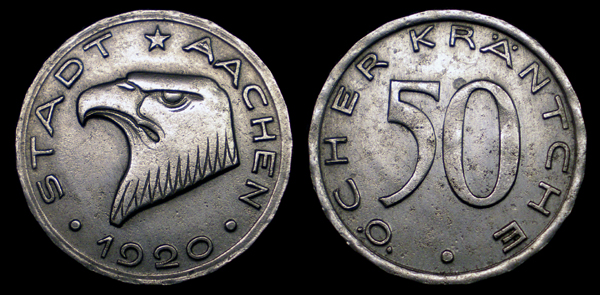
STADT AACHEN (GERMAN) 50 PFENNIG 1920
L- 1.7 City of Aachen (Rhineland) Iron 50 Pfennig Coin Depicting an Eagle
This iron coin depicting an eagle's head was issued by the City of Aachen and was meant to be used as small change.
Aachen is a city located in the state of North Rhine-Westphalia in Germany. The westernmost city in the country, it sits along the borders of Germany, Belgium and the Netherlands. Evidence suggests the site was used as an ancient quarry until the Romans discovered the remote area and used it for its natural hot springs calling the area Aquis-Granum. Later it became home to the Emperor Charlemagne who often wintered there. He built a Palace Residence in the city as well as the Palatine Chapel around 800 A.D. King Otto I was Crowned at Aachen in 936 and until 1531, most German Kings who became Holy Roman Emperors were Crowned in Aachen at the collegiate church built by Charlemagne.
Like most cities with such a long history, its fortunes rose and fell many times and by the mid 17th century Aachen had become a popular destination for its hot springs that were said to have curative properties. There is ample evidence to show that it was also well known for prostitution. Aachen was a place one might go to try for a cure, but with syphilis and sex workers, one might come home sicker than before one made the trip.
Aachen was chosen as the site of several important congresses and peace treaties: The first congress of Aachen (the Congress of Aix-la-Chapelle) in 1668 and the First Treaty of Aachen in the same year ending the War of Devolution. A second congress and a second treaty in 1748, finishing the War of the Austrian Succession. A third congress took place in 1818 to decide the fate of occupied Napoleonic France. The city was a part of France under Napoleon's first French Empire, a part of Prussia after his defeat.
By 1840 the railway and modern industry had reached Aachen. The city and its 80,000 citizens suffered from overcrowding that caused serious drainage and sewage problems. Many were forced to live in deplorable conditions until city planning could expand and alleviate the problem. By 1930, Aachen had became an important industrial center well known for the production of locomotives and a thriving iron works among other industries.
Today Aachen is no longer such an important industrial center though it still hosts a variety of business concerns such as electronics, chemicals, plastics, textiles, and glass to name a few. It is also a popular destination for tourists interested in the city's rich history and its many historical sites.
